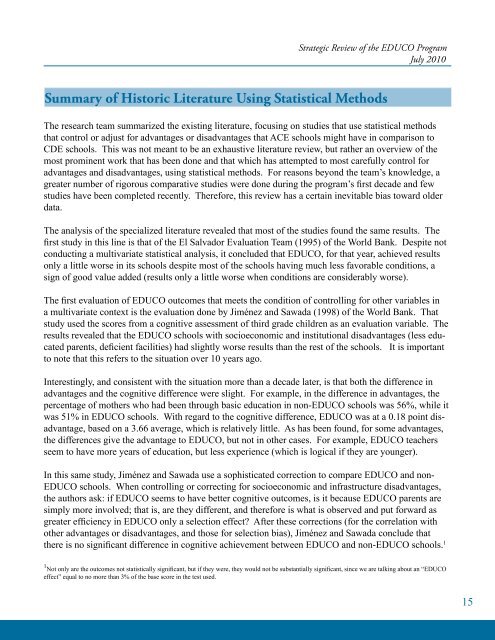Strategic Review of the EDUCO Program - EQUIP123.net
Strategic Review of the EDUCO Program - EQUIP123.net
Strategic Review of the EDUCO Program - EQUIP123.net
You also want an ePaper? Increase the reach of your titles
YUMPU automatically turns print PDFs into web optimized ePapers that Google loves.
<strong>Strategic</strong> <strong>Review</strong> <strong>of</strong> <strong>the</strong> <strong>EDUCO</strong> <strong>Program</strong>July 2010Summary <strong>of</strong> Historic Literature Using Statistical MethodsThe research team summarized <strong>the</strong> existing literature, focusing on studies that use statistical methodsthat control or adjust for advantages or disadvantages that ACE schools might have in comparison toCDE schools. This was not meant to be an exhaustive literature review, but ra<strong>the</strong>r an overview <strong>of</strong> <strong>the</strong>most prominent work that has been done and that which has attempted to most carefully control foradvantages and disadvantages, using statistical methods. For reasons beyond <strong>the</strong> team’s knowledge, agreater number <strong>of</strong> rigorous comparative studies were done during <strong>the</strong> program’s first decade and fewstudies have been completed recently. Therefore, this review has a certain inevitable bias toward olderdata.The analysis <strong>of</strong> <strong>the</strong> specialized literature revealed that most <strong>of</strong> <strong>the</strong> studies found <strong>the</strong> same results. Thefirst study in this line is that <strong>of</strong> <strong>the</strong> El Salvador Evaluation Team (1995) <strong>of</strong> <strong>the</strong> World Bank. Despite notconducting a multivariate statistical analysis, it concluded that <strong>EDUCO</strong>, for that year, achieved resultsonly a little worse in its schools despite most <strong>of</strong> <strong>the</strong> schools having much less favorable conditions, asign <strong>of</strong> good value added (results only a little worse when conditions are considerably worse).The first evaluation <strong>of</strong> <strong>EDUCO</strong> outcomes that meets <strong>the</strong> condition <strong>of</strong> controlling for o<strong>the</strong>r variables ina multivariate context is <strong>the</strong> evaluation done by Jiménez and Sawada (1998) <strong>of</strong> <strong>the</strong> World Bank. Thatstudy used <strong>the</strong> scores from a cognitive assessment <strong>of</strong> third grade children as an evaluation variable. Theresults revealed that <strong>the</strong> <strong>EDUCO</strong> schools with socioeconomic and institutional disadvantages (less educatedparents, deficient facilities) had slightly worse results than <strong>the</strong> rest <strong>of</strong> <strong>the</strong> schools. It is importantto note that this refers to <strong>the</strong> situation over 10 years ago.Interestingly, and consistent with <strong>the</strong> situation more than a decade later, is that both <strong>the</strong> difference inadvantages and <strong>the</strong> cognitive difference were slight. For example, in <strong>the</strong> difference in advantages, <strong>the</strong>percentage <strong>of</strong> mo<strong>the</strong>rs who had been through basic education in non-<strong>EDUCO</strong> schools was 56%, while itwas 51% in <strong>EDUCO</strong> schools. With regard to <strong>the</strong> cognitive difference, <strong>EDUCO</strong> was at a 0.18 point disadvantage,based on a 3.66 average, which is relatively little. As has been found, for some advantages,<strong>the</strong> differences give <strong>the</strong> advantage to <strong>EDUCO</strong>, but not in o<strong>the</strong>r cases. For example, <strong>EDUCO</strong> teachersseem to have more years <strong>of</strong> education, but less experience (which is logical if <strong>the</strong>y are younger).In this same study, Jiménez and Sawada use a sophisticated correction to compare <strong>EDUCO</strong> and non-<strong>EDUCO</strong> schools. When controlling or correcting for socioeconomic and infrastructure disadvantages,<strong>the</strong> authors ask: if <strong>EDUCO</strong> seems to have better cognitive outcomes, is it because <strong>EDUCO</strong> parents aresimply more involved; that is, are <strong>the</strong>y different, and <strong>the</strong>refore is what is observed and put forward asgreater efficiency in <strong>EDUCO</strong> only a selection effect? After <strong>the</strong>se corrections (for <strong>the</strong> correlation witho<strong>the</strong>r advantages or disadvantages, and those for selection bias), Jiménez and Sawada conclude that<strong>the</strong>re is no significant difference in cognitive achievement between <strong>EDUCO</strong> and non-<strong>EDUCO</strong> schools. 11 Not only are <strong>the</strong> outcomes not statistically significant, but if <strong>the</strong>y were, <strong>the</strong>y would not be substantially significant, since we are talking about an “<strong>EDUCO</strong>effect” equal to no more than 3% <strong>of</strong> <strong>the</strong> base score in <strong>the</strong> test used.15

















